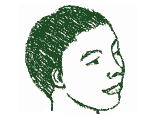|
Gen Y - Program and Curriculum Guide
Section II: Unit 6: Researching on the Web
- Search Tools and Strategies
- Evaluation of Web Resources
- Understanding Copyright and Citation
Unit 6 contains:
- Overview
- The Gen Y View
- Project ideas
- Terms to know
- 12 Infopages (handouts, quizzes, scripts, etc. on CD-ROM and online)
- Standards
- Activities with Prioritized Objectives
- 5 Lesson Plans - for one or more classroom periods. Each with:
- Materials
- Pre-lesson checklist
- Background information
- Procedures
- Assessment (print and online)
- Activity extensions
- Related issues
- Teacher Toolkit
- Alternate activities if hardware is not working
Evaluate the full curriculum guide. Click
here for details.
Sample Sections
Unit 6: Researching on the Web Overview
The World Wide Web represents the largest collection of facts, opinions,
information, and misinformation ever assembled in human history. Assembled
is a somewhat misleading term, however, for there is no centralized, managed
system for the organization of this vast collection of information. Although
useful material on any topic imaginable is undoubtedly available on the
WWW, finding it is the trick. There is no card catalog for the Web.
Given the emphasis on research and project-based learning in today�s
classrooms, the ability to search out and locate appropriate and reliable
information on the Web has rapidly become a basic skill. The Web provides
previously unimaginable access to current scientific data and information,
international experts on virtually any topic, government-sponsored databases,
and the thoughts and opinions of analysts and policy makers from around
the world�all in a matter of seconds.
This unit is intended to provide students with the basic knowledge and
skills necessary to conduct efficient and successful searches of the Web.
It also addresses the legal and ethical issues of copyright and citation.
Because the Web, with its highly visual, interactive format, has largely
supplanted earlier Internet-based applications, such as FTP and Gopher
(and provides access to the information contained at FTP and Gopher sites
in any event), the content and activities of this section focus exclusively
on the Web.
Activities & Prioritized Objectives
Following the completion of Unit 6, students will be able to:
| Activity 1�Search Tools for the Web |
| |
1.1 |
Understand the structure and purpose of the Web and
the range of information that can be found on the Web. |
| |
1.2 |
Describe the parts and mechanics of a Web browser |
| |
1.3 |
Accurately and efficiently use a browser to navigate
the Web |
| |
1.4 |
Identify the principle features of a Web page (e.g.,
title, location, URL, etc.) |
| |
1.5 |
Understand the similarities and differences among search
engines, search directories, and metasearch engines |
| |
1.6 |
Use several different search tools to locate specific
online information |
| |
|
|
| Activity 2�Search Strategies for the Web |
| |
2.1 |
Understand some of the features of advanced searches |
| |
2.2 |
Refine searches to achieve different results (using
Boolean terminology, truncation, keywords, etc.) |
| |
2.3 |
Explain differing results that are produced by
different Web searches |
| |
|
|
| Activity 3�Evaluation Criteria for Web Sites |
| |
3.1 |
State and apply criteria or standards for evaluating
online information and explain why each criterion is important |
| |
3.2 |
Evaluate the validity of the information in a Web site
|
| |
3.3 |
Identify the source of Web materials |
| |
3.4 |
Determine the audience for which a Web site was designed |
| |
|
|
| Activity 4�Locating and Evaluating Educational Resources
on the Web |
| |
4.1 |
Locate instructional support resources on the Web and
give examples of how those resources might be used in a classroom
|
| |
4.2 |
Evaluate the validity of the educational sites located |
| |
4.3 |
Create, use, and organize bookmarks |
| |
|
|
| Activity 5�Understanding Copyright and Citation |
| |
5.1 |
Download images and text from the Web |
| |
5.2 |
Explain what is meant by copyright and describe where
to find the copyright rules that apply to online information |
| |
5.3 |
For sample cases of information, indicate whether that
information is copyrighted and how much (if any) of that information
can be used without obtaining permission from the copyright holder.
Discuss what sorts of uses require permission. |
| |
5.4 |
Describe the steps to take to obtain permission to
use copyrighted material |
| |
5.5 |
Accurately cite sources of material taken from the
Web |
Next: Unit 7: Online Collaborative Learning
Unit 1 | Unit
2 | Unit 3 | Unit
4 | Unit 5 | Unit 6 | Unit
7 | Unit 8 | Unit
9 | Unit 10
|

